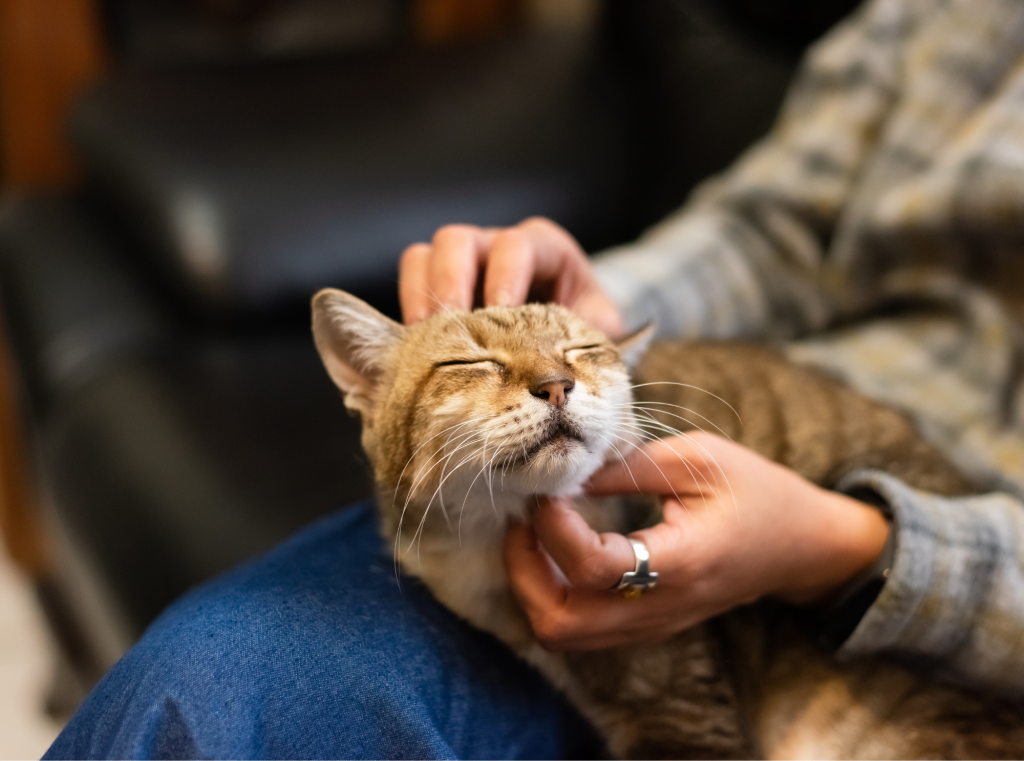Understanding the Body Language of Pets: Signs of Stress and Comfort in Dogs and Cats

Decoding Your Furry Friends
Every pet owner knows that their companions communicate, but often, these messages are not verbal. Understanding your pet’s body language can significantly enhance the bond you share. Recognizing signs of stress and comfort in dogs and cats is essential for their well-being, and it fosters an environment where they can thrive.
Why Is It Important?
Pets experience a range of emotions, and being attuned to their non-verbal cues can help you address their needs effectively. Observing their behavior allows you to identify what makes them feel safe or threatened, crucial for creating a supportive home. For example, in a household with children, a dog that is constantly hiding may be stressed by the noise and activity, while a cat that greets you at the door is signaling comfort and affection.
Here are some critical signs to watch for:
- Stress Signals: Common indicators include whining, pacing, excessive grooming, which can be a sign of anxiety, or hiding, where your pet seeks a quiet corner to feel safe. Other signs may include excessive barking or destructive behavior, especially in dogs who feel overwhelmed.
- Comfort Indicators: On the other side, comfort signals manifest as a relaxed body posture—think of a dog lying belly up or a cat curled up in a sunbeam. Gentle play behavior like a cat batting at a feather toy, soft purring, or a tail wagging slowly and low typically indicates a relaxed and secure pet.
It’s worth noting that each pet has its unique way of expressing feelings, making close observation essential. For instance, a dog that rolls onto its back can indicate submission or comfort, while a cat that puffs up its fur and arches its back is likely feeling threatened or scared. Another example is the ‘slow blink’ in cats—a gesture that can signify trust and affection, often referred to as a “cat kiss.”
What’s Next?
Diving deeper into the fascinating world of pet communication can empower you to react appropriately to their needs. By learning to recognize these signs, you are taking an essential step towards fostering a more harmonious environment for your cherished companions. It might also lead to greater insights into their health, as changes in behavior can signal underlying medical issues that require attention.

Stay tuned as we explore specific behaviors and what they reveal about your pet’s emotional state. From interpreting playful antics to deciphering anxious tendencies, understanding your pet’s communication can dramatically strengthen your relationship and enhance their quality of life.
DISCOVER MORE: Click here for effective training tips
Recognizing the Signs of Stress
Understanding your pets’ body language begins with recognizing the signs of stress. Dogs and cats, though different in their tendencies, exhibit clear behavioral changes when they feel uneasy. Being aware of these signs allows you to intervene and provide a supportive environment that alleviates their anxiety. Whether due to environmental changes, new visitors, or underlying health concerns, stress can manifest in various ways.
In dogs, some common stress signals include:
- Whining or whimpering: Persistent vocalizations often indicate discomfort or anxiety.
- Pacing: An anxious dog may walk back and forth, unable to settle down.
- Excessive grooming: This behavior, especially in cats, can signal stress or boredom.
- Hiding: If your dog seeks refuge in a quiet corner or under furniture, it may be overwhelmed.
- Destructive behavior: Chewing on furniture or digging can reveal an overwhelmed mind struggling to cope.
Cats, while often more subtle in their expressions of stress, exhibit distinctive signs as well. Common stress-related behaviors include:
- Flattened ears: When a cat’s ears lay back against its head, it often signals fear or aggression.
- Baring teeth or hissing: These are defensive actions that indicate that your cat feels threatened.
- Avoiding eye contact: Cats will often look away when they feel uncomfortable or unsafe.
- Litter box avoidance: Changes in litter box habits can be a sign of stress-related issues.
Identifying these signals is crucial not only for their immediate comfort but also for long-term well-being. For example, a barking dog may require more calming exercise or interactions if it feels anxious at home. Similarly, a cat that withdraws may benefit from additional affection or environmental enrichment. Understanding your pet’s unique behavioral patterns helps in tailoring an approach that suits their personality, promoting greater emotional stability.
Creating a Comfort Zone
While stress management is vital, it’s equally important to observe the signs that indicate comfort and security. Pets will display ease through their body language, signaling that they feel safe in their surroundings. For example, a dog that rolls over and shows its belly is not only inviting a scratch but also demonstrating trust in its environment. Likewise, a cat that stretches out in a sunbeam, eyes half-closed, is in a state of relaxation, often paired with gentle purring.
Additional indicators of a comfortable pet include:
- Playfulness: A pet that engages in social play is likely comfortable with its surroundings.
- Seeking proximity: When a pet approaches you for attention or cuddles, it shows a sense of security.
- Slow tail wags or purring: These are clear signs of a relaxed and happy pet, reflecting contentment.
By learning to interpret these signs, you set a foundation for better communication with your furry companions. As is clear, recognizing both stress and comfort indicators plays a pivotal role in nurturing an enriching environment, ultimately leading to enhanced emotional health for both dogs and cats.
| Category | Description |
|---|---|
| Signs of Stress | Rapid barking, increased heart rate, or hiding can indicate a stressed pet. |
| Indicators of Comfort | Relaxed posture, playful behavior, and soft eyes show a pet is comfortable. |
| Understanding Signals | Recognizing your pet’s signals can enhance bonding and provide insights into their emotional state. |
| Observation Techniques | Using consistent observation helps in identifying stress triggers and creating a comfortable environment for pets. |
Understanding your pet’s body language not only fosters a loving relationship but also plays a crucial role in their well-being. For example, a dog that exhibits a stiff body and yawning may be signaling discomfort or anxiety. Similarly, cats may display similar signs, such as flattened ears or a swishing tail, indicating they are stressed or annoyed. By recognizing these signs, pet owners can intervene appropriately, whether it’s providing a safe space or engaging in calming activities. Moreover, such insights can enhance communication, allowing pets to feel secure and understood. This informative approach paves the way for a deeper understanding of pet behavior, reinforcing the bond between humans and their beloved companions.
ENSURE YOUR PET’S HAPPINESS: Click here to learn more
Interpreting the Signals of Anxiety and Contentment
Once you grasp the signs of stress and comfort that your pets exhibit, the next step is understanding their implications in the broader context of their well-being. Each behavior serves as a narrative about your pet’s emotional state and can help inform decisions about their environment, interactions, and overall care.
It is important to recognize that stress in pets can result from various factors. For instance, exposure to loud noises, such as thunderstorms or fireworks, is well-known to frighten dogs and cats alike. Observing your pet during these events can reveal specific reactions. A dog may pace restlessly or try to hide, while a cat may become agitated and attempt to flee to a safe space. If these behaviors are frequent, developing a response plan, such as creating a designated quiet area with comforting toys and scents, can be an effective way to manage anxiety.
Additionally, environmental changes can be a considerable source of stress for pets. Moving to a new home, introducing new family members, or even rearranging furniture can disrupt a pet’s sense of security. To ease this transition, take the time to reassure and comfort them. Familiar items, such as their bedding or favorite toys, should be kept within reach to provide a sense of continuity. It’s essential to maintain a routine as much as possible, as it helps to anchor pets in their new surroundings.
Another critical factor to consider is the impact of underlying health issues on your pet’s behavior. Changes in body language, such as decreased playfulness or an increase in aggression, can often signify pain or discomfort related to medical conditions. Regular veterinary check-ups are crucial in identifying and addressing potential health problems early. Understanding that behaviors like excessive grooming in cats can also indicate stress, boredom, or even skin conditions is key in maintaining their health.
Enhancing the Environment for Emotional Well-Being
Creating an environment that promotes comfort can make a world of difference in your pet’s life. Inadequate stimulation can lead to boredom and stress in both dogs and cats. Interactive toys, structured playtime, and mental challenges, such as puzzle feeders, can help keep your pets engaged, allowing them to expend energy in productive ways. Regular walks and outdoor exploration not only provide physical exercise but also stimulate their senses, fostering emotional stability.
Another significant aspect is the power of social interactions. Dogs are naturally social animals, and introducing them to new playmates can enhance their confidence and reduce feelings of isolation. Similarly, a sociable cat may thrive in a multi-pet household, finding comfort in companionship. However, always monitor interactions to ensure that they are positive and not overwhelming.
Furthermore, the bond you build with your pets through positive reinforcement and trust-building exercises is essential. Simple actions like using a calm voice to reassure them during stressful moments, or rewarding them with treats for exhibiting calm behavior, can strengthen their feelings of safety.
In conclusion, understanding the body language of your pets, including the signs of stress and comfort, enables you to create an enriching and nurturing environment that caters to their emotional and physical needs. By observing their behaviors and making adjustments accordingly, you foster a lifetime of trust and companionship with your furry friends.
DISCOVER MORE: Click here to learn why post-adoption support is essential
Conclusion: The Key to a Harmonious Relationship
In the journey of pet ownership, understanding the body language of our companions is not just a skill but a vital aspect of fostering a strong, trusting relationship. The signs of stress and comfort exhibited by our dogs and cats tell us stories about their emotional well-being and guide us in making thoughtful choices regarding their care. By being observant and informed, we can recognize when our pets are anxious or at ease, allowing us to respond appropriately to their needs.
By addressing frequent sources of stress—such as environmental changes, loud noises, or health issues—we can significantly improve their quality of life. Creating a safe and stimulating environment is equally important, as properly engaging our pets through play, socialization, and comforting routines can reduce anxiety and enhance overall happiness. Moreover, understanding the root causes of specific behaviors prompts a deeper connection with our pets, leading us to seek professional advice when necessary.
Ultimately, the key takeaway is that being attuned to our pets’ body language is a continuous learning process. The more we observe and interpret their signals, the closer we become to understanding their feelings and experiences. This knowledge empowers us to be better caregivers, contributing to the health and happiness of our furry friends. As you continue to educate yourself about your pets’ unique behaviors, you also nurture the profound bond of trust and companionship that can last a lifetime.



